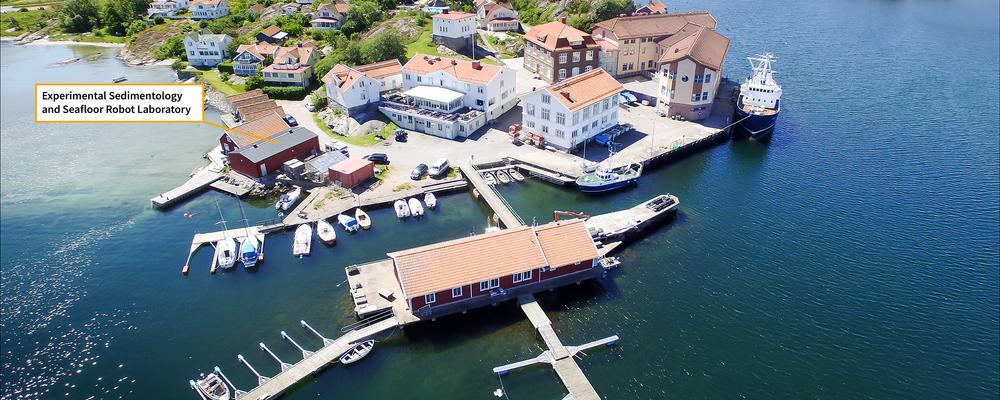
Experimental Sedimentology and Seafloor Robot Laboratory
This lab provides a unique environment for cutting-edge studies in marine particle dynamics. The 150 square meter facility, equipped with advanced instrumentation and a state-of-the-art seawater flume, is ideally positioned adjacent to Gullmarsfjord, enabling direct access to both surface and deep waters. Here, we utilize laboratory experiments and seafloor robotics to study sediment dynamics, such as erosion, deposition, and transport. This integration of technology and science establishes the lab as a crucial site for oceanic research, with a particular focus on the ocean carbon cycle and seabed particulate flows.
Understanding global change and its societal impacts also requires advancing and applying process-oriented research in sedimentology in an interdisciplinary approach. Mud is the dominant sediment surface cover in the ocean and is very complex as a substance. It comprises many small inorganic particles that freely bind with organic matter to form aggregates.
Our research group uses laboratory and field studies to explore small-scale, basic processes of erosion, deposition and transport of organo-mineral particles, applies remote sensing to investigate larger scale patterns of sediment distribution, and models to predict the fate of particles in the ocean. The primary focus is on the ocean carbon cycle and the fluxes of particulate matter within the lowermost water column close to the seabed, with special emphasis on aggregation processes. Our approach is twofold, with lab experiments and tele-operated or fully autonomous seafloor robots. Both approaches mainly rely on the use of sensors.
The laboratory
The Experimental Sedimentology and Seafloor Robot Laboratory at Kristineberg Center is a stand-alone, 150 m2 building equipped to facilitate physical experiments to study particle dynamics in marine environments. The lab is located next to the Gullmarsfjord with access to filtered surface and deep water. Research vessels of up to 60 m length can use the pier of the field station. The Swedish offshore site Bratten is just 30 nm away and is used as one major study site for two EU funded projects “Redress” on marine restoration (27 partners) and “Digi4Eco” on digital twin technology (18 partners).
Seawater flume
One large state-of-the-art seawater flume allows us to study processes at continental margins and the deep sea. The racetrack flume is 20 m long, 0.7 m wide, and 0.3 m deep. The test section can hold sediments from a large boxcorer (0.25 m2, 40 cm deep). The flume is capable of recirculating water and sediments, and equipped with instruments to make high-resolution measurements of evolving bed topography, hydrodynamics, and particle fluxes. The propulsion system generates flow velocities of 0 – 30 cm/s using a caterpillar track which only little influences particle size. During the winter period, temperatures in the room can be kept around 2-5 °C.
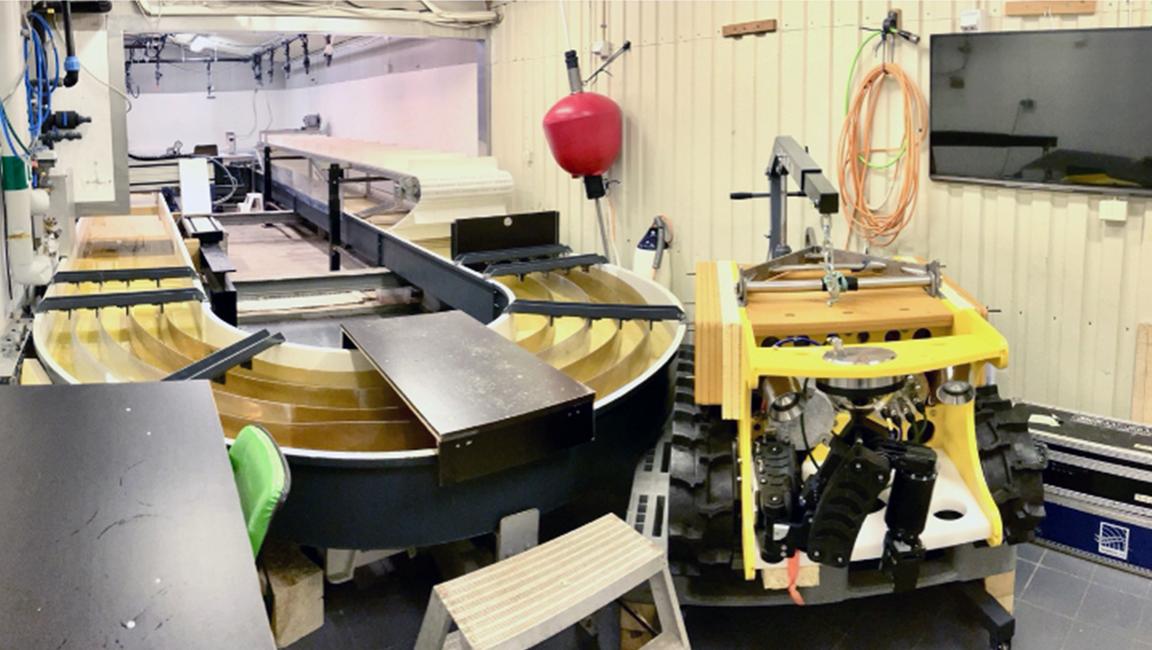

Coolroom with water column simulator
One 20 m2 coolroom within the main building of Kristineberg Center is used to simulate processes in both the water column and the bottom boundary layer under controlled temperature conditions of 4 °C. A 1000 l water column simulator allows to study sediment plumes and sedimentation under calibrated turbulent conditions (shelf sea / deep sea) and can be modified to quantify processes at the sediment water interface.
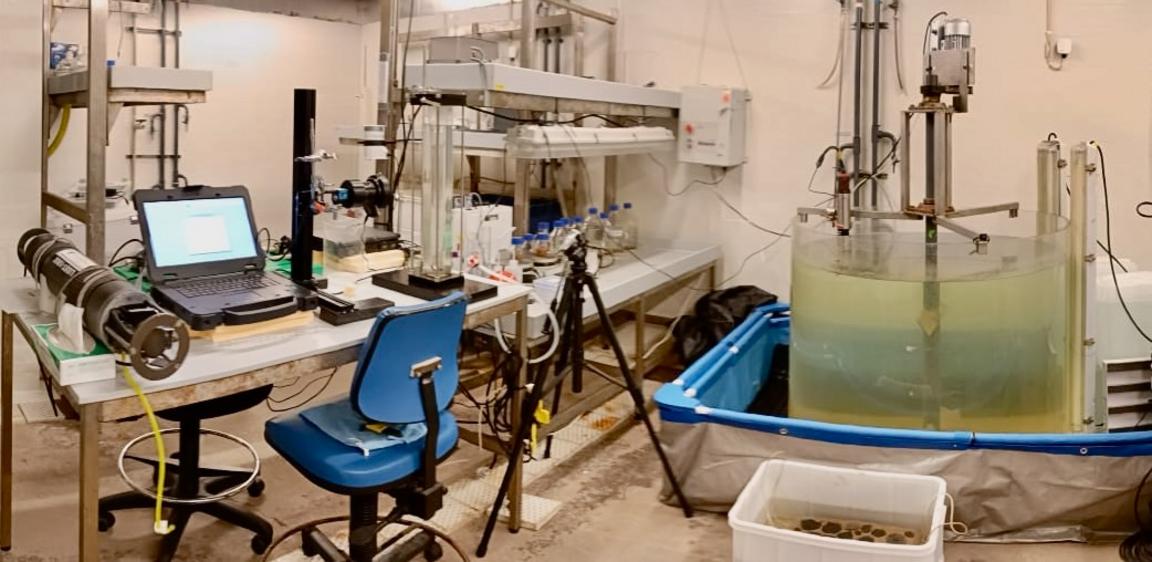
One coolroom of the facility is used to study particle transport under deep-sea temperature conditions The transportation of deep-sea sediments to Kristineberg Center can be accomplished by a coolchain, allowing for subsequent analysis of particle properties and aggregation behavior. Particle size and settling velocity are determined by a LISST particle sizer, a particle camera, settling tube, roller tanks and a 1000 l water column simulator. An Aqualog turbidity meter can analyze a wide range of particle concentrations from 10 mg to 50 g / l. The sink in the room is securely sealed to avoid any inadvertent release of Pacific water into the Gullmarsfjord.
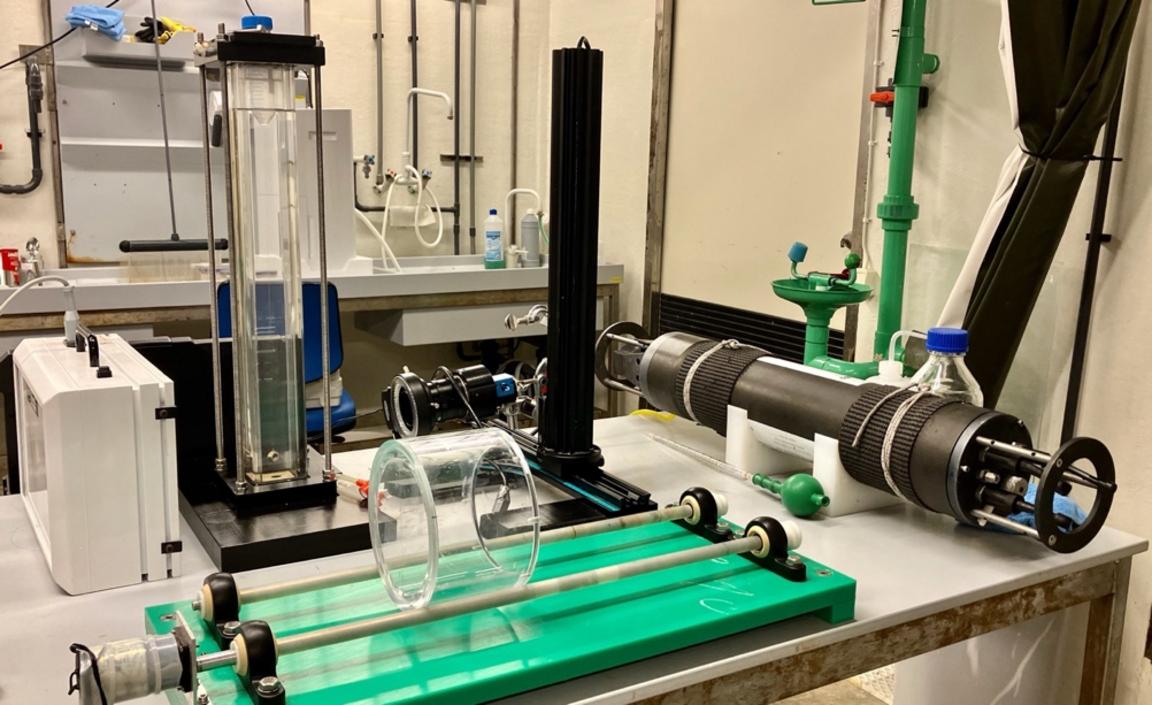
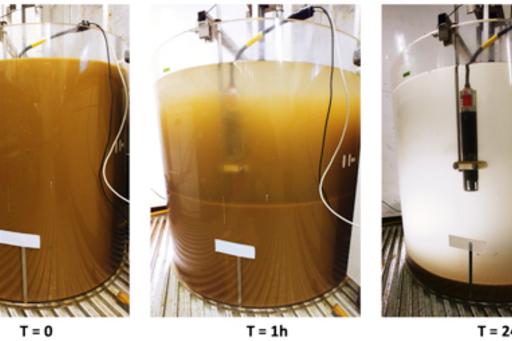
The roller tanks, settling tube, particle cameras as well as a set of sensors for particle characterization (turbidity, backscatter, fluorescence, size, settling velocity, critical shear stress of sediments, aggregation under low and highly turbulent conditions) are applied. Benthic chambers (30, 20, 10 cm diameter) can be used to study resuspension behavior and porewater flow under different hydrodynamical conditions. Two pressure laboratories (0.1 – 25 MPa) enable the study of the effect of hydrostatic pressure on organic matter fluxes, as well as aggregation.
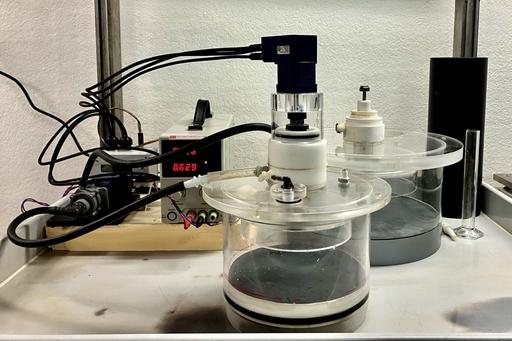

This variety in geometric and operational characteristics provides an exceptional opportunity to conduct experiments at different scales and complexities. This experimental capacity is combined with our years of expertise in particle dynamics.
Reproduction of sediment ripples from gravity currents using the 20 m sea flume:

The seawater flume in Kristineberg Center is also used to reproduce in-situ observations from remote deep sea areas (here from the Clarion Clipperton Zone) to understand ripple formation after gravity currents passed through an area covered by manganese nodules
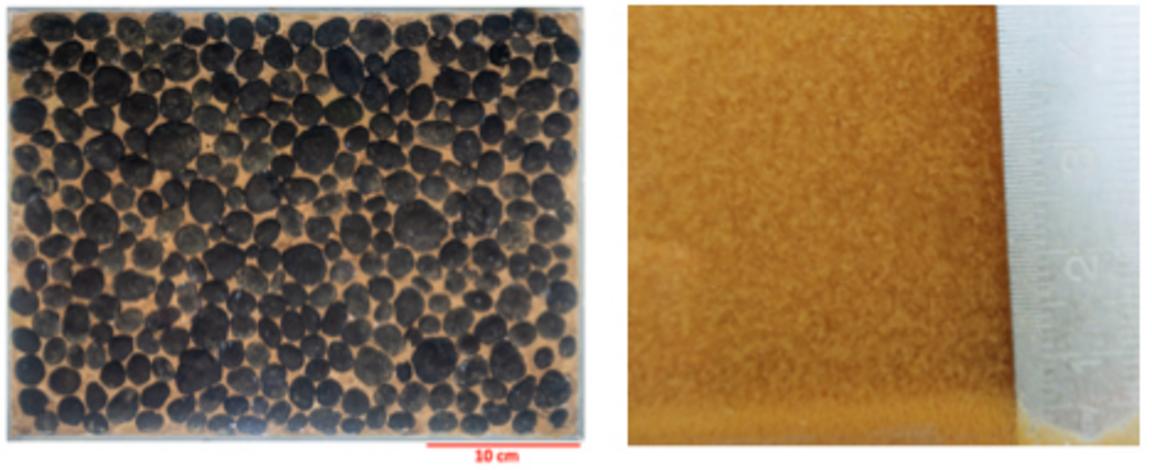
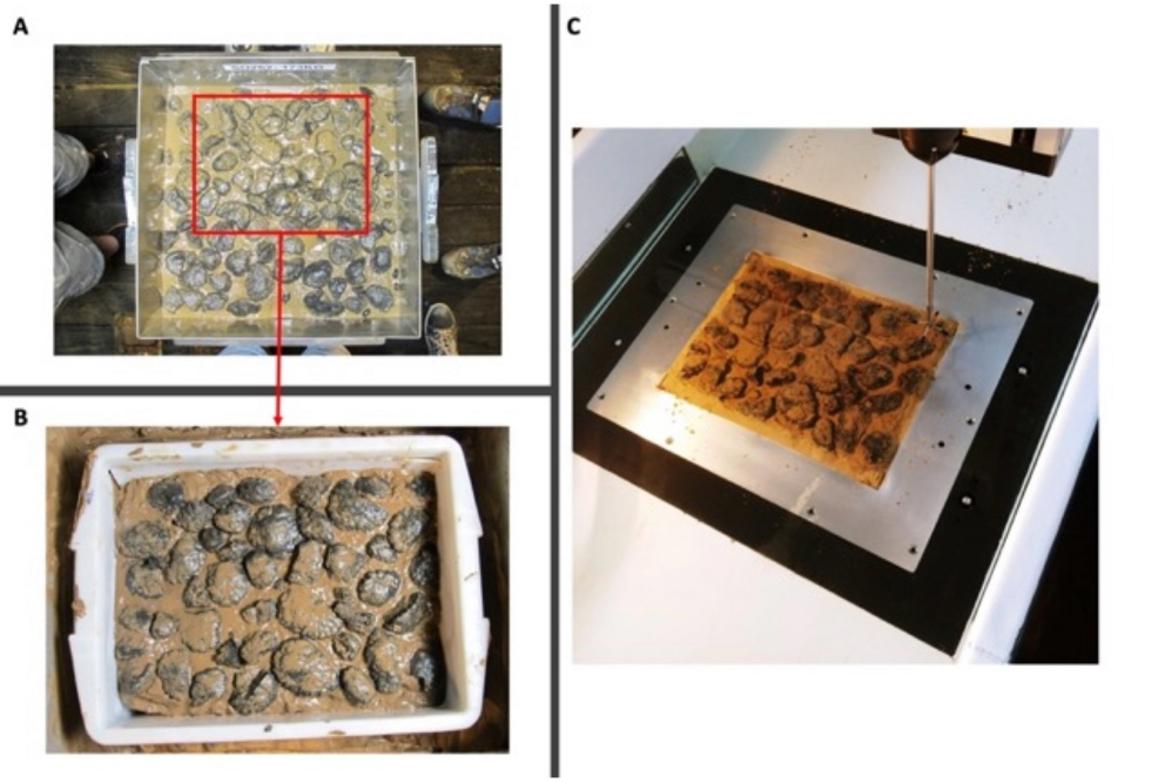
People and expertise
Group leader
Laurenz Thomsen
PhD students
Jan Eike Rossius
Master student
Nayomi Edrisinghe
Tim Dorup
Nicola Philbert
Linnea Kivi
Field observations
The mesocosm facilities are complemented by two seafloor robots which were developed by the working group between 2004 and 2020. They are tele-operated and can be controlled with a surface buoy from a distance of up to 2 km with a laptop. The connection is either established via surface buoy or from a junction box located at the sediment surface. This setup also allows to robot to be controlled via internet from anywhere in the world. The robots are used on shelf seas and continental slopes in Sweden or, like the Wally-Crawler, as part of a cabled observatory like Ocean Networks Canada at 900 m water depth. The robots can be equipped with the same sensors which are used for the laboratory experiments including benthic chambers. A manipulator on one crawler (Seaterra, Germany) allows to actively interact with the environment and place specific sensors (e.g. Raman spectroscopy).
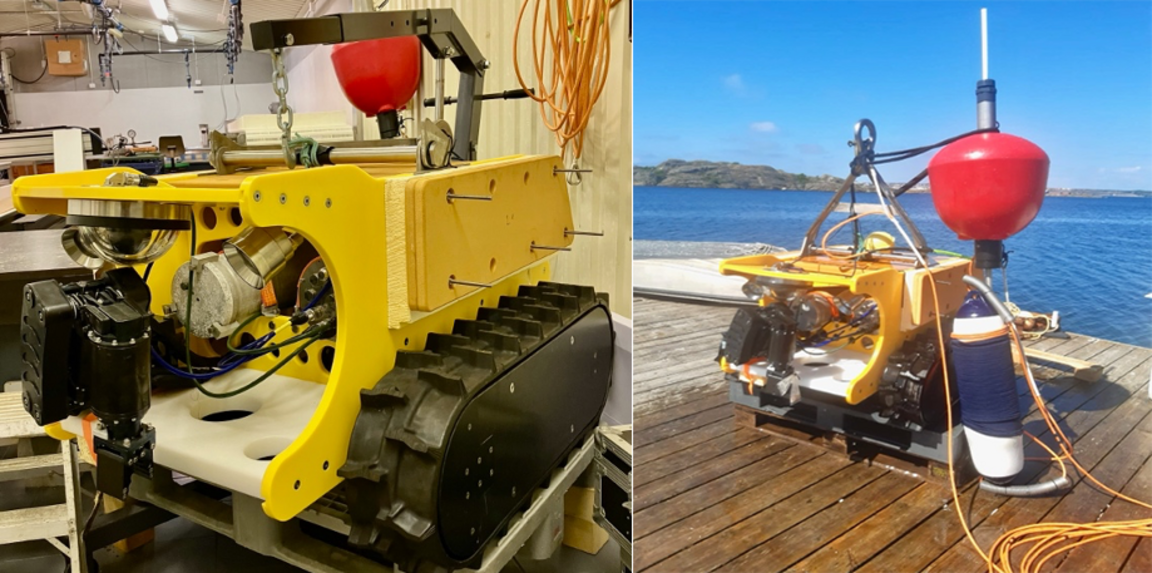
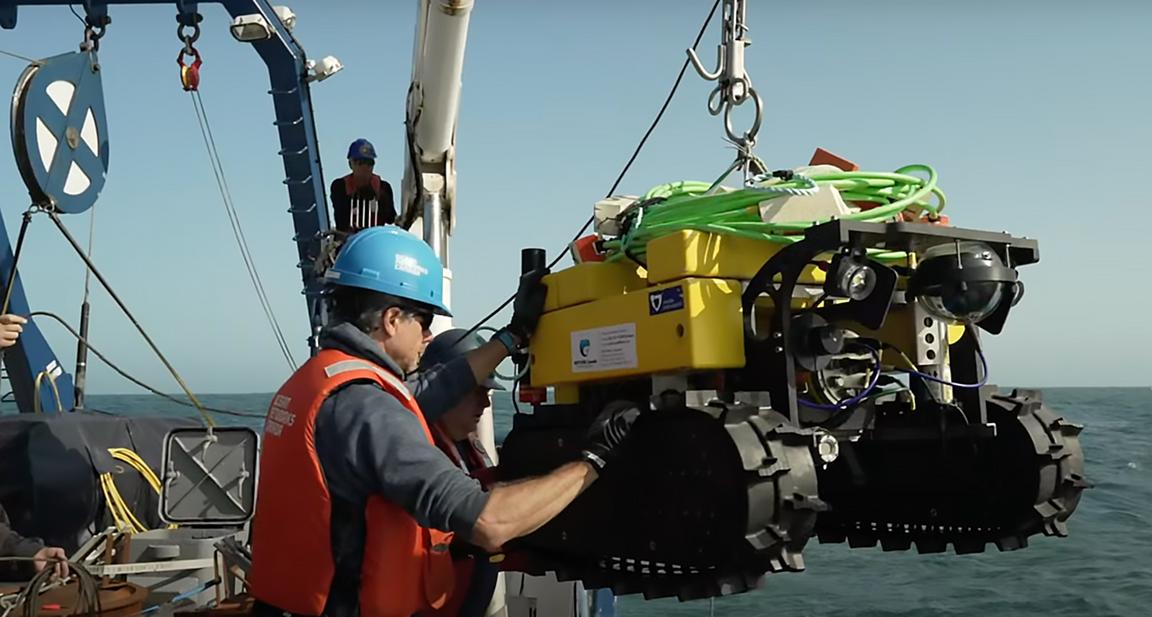
Deployment of Wally the Crawler during a research cruise of ONC to Barkley Canyon. One crawler will be deployed in Barkley Canon again in 2024, one Wally (above) crawler has retired after 10 years of regular 12-18 months deployments at 900 m water depth and will work in the Gullmarsfjord for the next years.
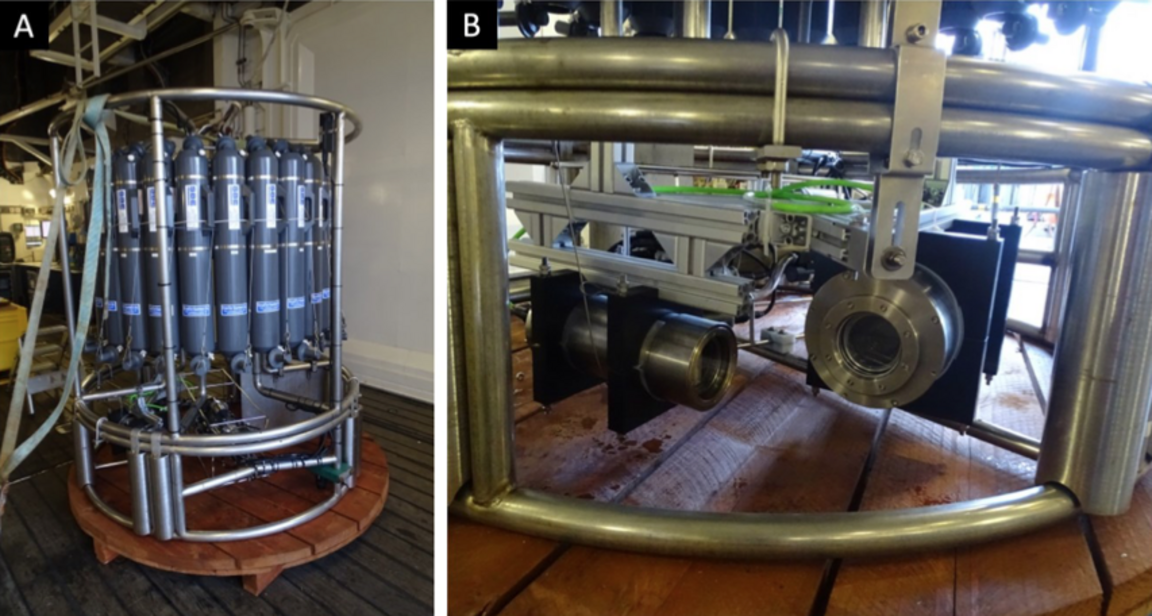
What we offer
Experimental investigations
- State-of-the-art measuring equipment
- Particle-water interactions
- Flow visualization (e.g. ADV)
- Bespoke instrumentation development for challenging problems.
Numerical simulations in collaboration with partners
- Development of fit-for-purpose numerical models.
- Computational Fluid Dynamics (CFD)
- Digital twins of laboratory and field metocean conditions (EU Digi4Ocean project).
- Coastal evolution and modelling
- Ecosystem modelling
Field data analysis
- Analysis and interpretation of in-situ measurements
- Coastal processes and modelling using robots and satellite measurements
- Robotic inspection of seafloor features below diver depth, even under high currents
Analytical developments
- Particle characteristics (d50 (4 – 4000 µm), ws, ucri )
- Aggregation behavior
- Analytical description of plume dispersal
- Image analyses of near bottom processes and objects
Current research themes
- Deep sea mining
- Deep sea and shallow water ecosystem restoration
- Digital twin
- Carbon fluxes in canyons
- Large scale carbon sequestration
- Sensor development for ROS2 operations
Contact
Laurenz Thomsen
Professor
+46 766-18 30 10
+46 31-786 30 10
laurenz.thomsen@gu.se
Projects
In early 2024, the two EU projects REDRESS (26 partners) and Digi4Eco (18 partners) kicked off. Kristineberg Center, with its sedimentology lab and the robots, will serve as hub for research vessels and experimental sites focusing on topics of deep-sea restoration and Digital Twin technology. One of the study sites which extend from Iceland to the Easter Mediterranean is the Bratten site, only 30 nautical miles away from the lab.
One other ongoing project with DHI tackles the impact of sediment plumes generated by deep sea mining in the central Pacific´s Clarion Clipperton Zone.
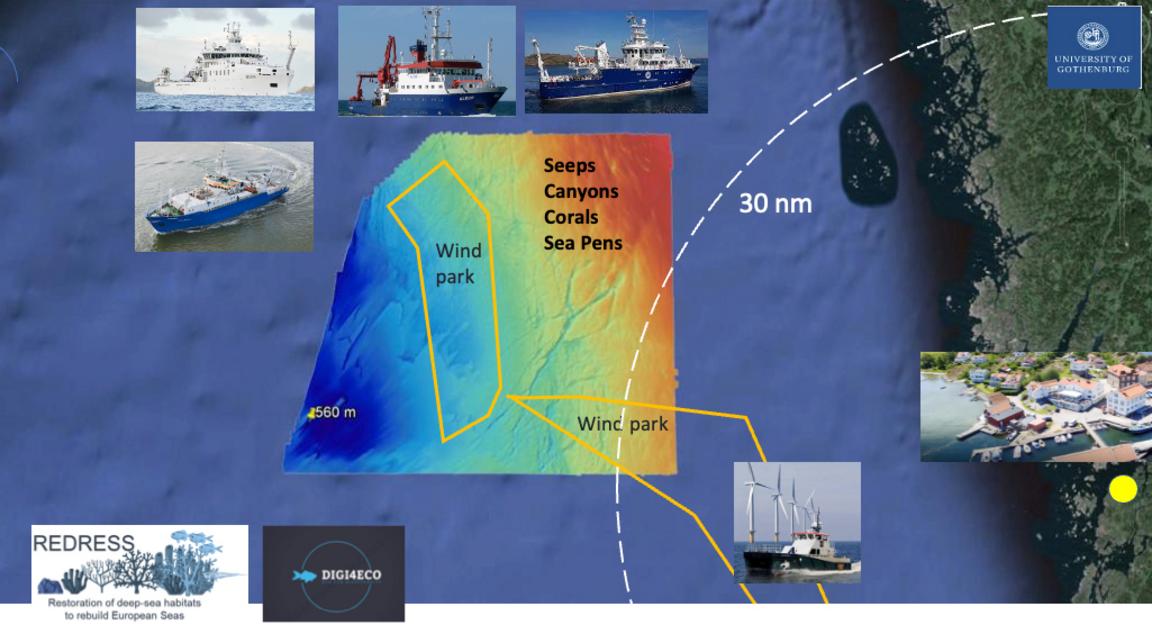

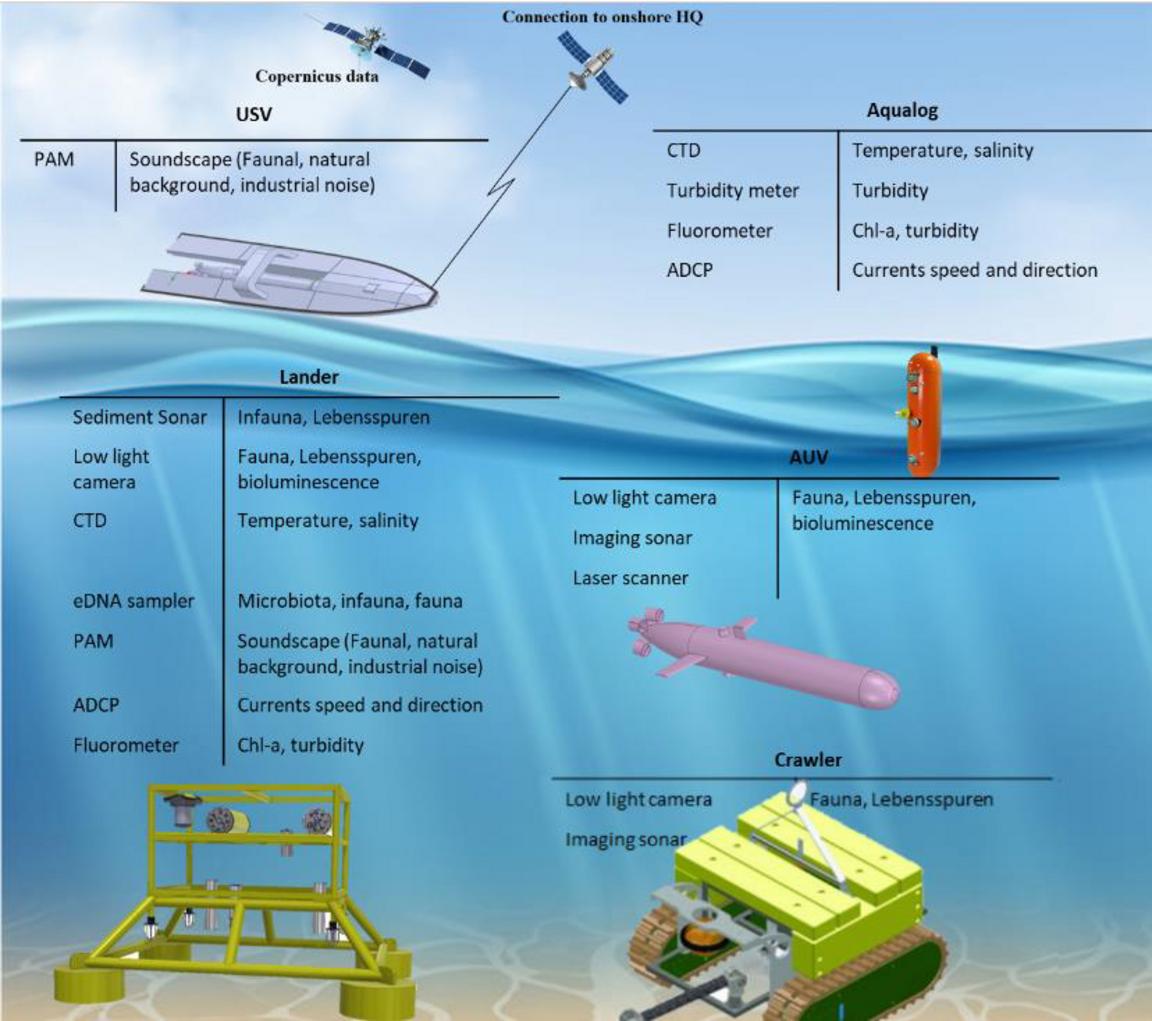
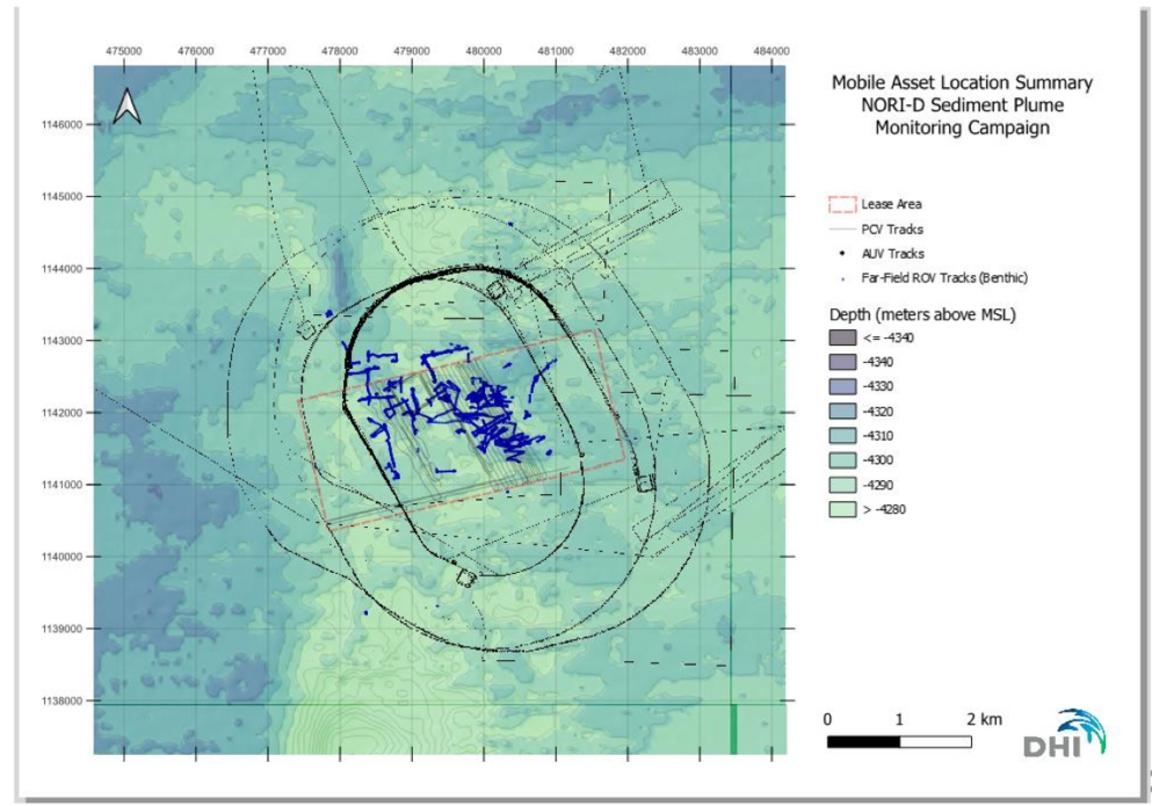
Collaborations
Publications
More info on Laurenz Thomsen and publications
Gazis, I. Z., de Stigter, H., Mohrmann, J., Heger, K., Diaz, M., Gillard, B., ...Thomsen & Greinert, J. (2025). Monitoring benthic plumes, sediment redeposition and seafloor imprints caused by deep-sea polymetallic nodule mining. Nature Communications, 16(1), 1229.
Aguzzi, J., Thomsen, L. et al., (2024). New Technologies for Monitoring and Upscaling Marine Ecosystem Restoration in Deep-Sea Environments. The EU Redress project. Engineering (Elsevier)
Falahzadeh, A., Toma, D.M., Francescangeli, M., Chatzievangelou, D., Nogueras, M., Martínez, E., Carandell, M., Tangerlini, M., Thomsen, L., Picardi, G. and Le Bris, M., (2023). A New Coastal Crawler Prototype to Expand the Ecological Monitoring Radius of OBSEA Cabled Observatory. Journal of Marine Science and Engineering, 11(4), p.857.
Chatzievangelou, D., Thomsen, L., Le Besnerais, C. D., Purser, A., & Aguzzi, J. (2022). Transects in the deep: opportunities with tele-operated resident seafloor robots. Frontiers in Marine Science, 1572.
Haaboom, S., Schoening, T., Urban, P., Gazis, I.Z., Stigter, H.D., Gillard, B., Baeye, M., Hollstein, M., Purkiani, K., Reichart, G.J. and Thomsen, L. (2022). Monitoring of anthropogenic sediment plumes in the Clarion-Clipperton Zone, NE equatorial Pacific Ocean. Frontiers in Marine Science, p.699
Weaver, P., …Thomsen, L. et al. (2022). Assessing plume impacts caused by polymetallic nodule mining vehicles, Marine Policy 139 (2022): 105011.
Purkiani, K., Gillard, B., Paul, A., Haeckel, M., Haalboom, S., Greinert, J., Stigter, H.D., Hollstein, M., Baeye, M., Vink, A. and Thomsen, L., 2021. Numerical simulation of deep-sea sediment transport induced by a dredge experiment in the northeastern Pacific Ocean. Frontiers in Marine Science, p.1175.
Hakim, A., Kobayashi, M., 2021. Aggregation and aggregate strength of microscale plastic particles in the presence of natural organic matter: effects of ionic valence. J Polym Environ 29, 1921–1929.
Aguzzi, J., Albiez, J., Flögel, S., Godø, O.R., Grimsbø, E., Marini, S., Pfannkuche, O., Rodriguez, E., Thomsen, L., Torkelsen, T. and Valencia, J., (2020). A Flexible Autonomous Robotic Observatory Infrastructure for Bentho-Pelagic Monitoring. Sensors, 20(6), p.1614.
Chatzievangelou, D., Aguzzi, J., Ogston, A., Suárez, A., & Thomsen, L. (2020). Visual monitoring of key deep-sea megafauna with an Internet Operated crawler as a tool for ecological status assessment. Progress in Oceanography, 102321
Danovaro R., Fanelli E., Aguzzi J3, Carugati L., Corinaldesi C., Dell’Anno A., Gjerde K, Jamieson A.J., Kark S., McClain C., Levin L., Levin N., Ramirez-Llodra E., Ruhl H., Smith C.R., Snelgrove P.V.R. Thomsen L., Van Dover C., Yasuhara M. (2020). Ecological variables for developing a global deep-ocean monitoring and conservation strategy. Nature Ecology & Evolution 04, 181-192
Gillard, B., Purkiani, K., Chatzievangelou, D., Vink, A., Iversen, M. H., & Thomsen, L. (2019). Physical and hydrodynamic properties of deep sea mining-generated, abyssal sediment plumes in the Clarion Clipperton Fracture Zone (eastern-central Pacific). Elem Sci Anth, 7(1).
Hakim, A., Suzuki, T., Kobayashi, M., 2019. Strength of Humic Acid Aggregates: Effects of Divalent Cations and Solution pH. ACS Omega 4(5), 8559–8567
Hakim, A., Kobayashi, M., 2019. Charging, aggregation, and aggregate strength of humic substances in the presence of cationic surfactants: Effects of humic substances hydrophobicity and surfactant tail length. Colloids and Surfaces A: Physicochemical and Engineering Aspects, 577, pp. 175-184.
Hakim, A., Kobayashi, M., 2018. Aggregation and charge reversal of humic substances in the presence of hydrophobic monovalent counter-ions: Effect of hydrophobicity of humic substances. Colloids and Surfaces A: Physicochemical and Engineering Aspects, 540, pp. 1-10
Thomsen L, Aguzzi J, Costa C, De Leo F, Ogston A, Purser A (2017) The Oceanic Biological Pump: Rapid carbon transfer to depth at Continental Margins during Winter. Scientific reports , 7
Danovaro, R., Aguzzi, J., Fanelli, E., Billett, D., Gjerde, K., Jamieson, A., Ramirez-Llodra, E., Smith, C.R., Snelgrove, P.V.R., Thomsen, L. and Van Dover, C.L., 2017. An ecosystem-based deep-ocean strategy. Science, 355(6324), pp.452-454.
Chatzievangelou, D., Doya, C., Thomsen, L., Purser, A., & Aguzzi, J. (2016). High-Frequency Patterns in the Abundance of Benthic Species near a Cold-Seep–An Internet Operated Vehicle Application. PloS one, 11(10), e0163808.
Brandt, A., Gutt, J., Hildebrandt, M., Pawlowski, J., Schwendner, J., Soltwedel, T., & Thomsen, L. (2016). Cutting the Umbilical: New Technological Perspectives in Benthic Deep-Sea Research. Journal of Marine Science and Engineering,
Thomsen, L., Purser, A., Schwendner, J., Duda, A., Flögen, S., Kwasnitschka, T., ... & Rosta, R. (2015, May). Temporal and spatial benthic data collection via mobile robots: Present and future applications. In OCEANS 2015-Genova (pp. 1-5). IEEE.
Godø O R, Klungsøyr J, Meier S, Tenningen E, Purser A, Thomsen L (2014). Real time observation system for monitoring environmental impact on marine ecosystems from oil drilling operations. Marine Pollution Bulletin
Purser, A., Thomsen, L., Barnes, C., Best, M., Chapman, R., Hofbauer, M., & Wagner, H. (2013). Temporal and spatial benthic data collection via an internet operated Deep Sea Crawler. Methods in Oceanography, 5, 1-18.
Larsson, A., Oevelen, D., Purser, A., Thomsen,L. (2012) Tolerance to long-term exposure of suspended benthic sediments and drill cuttings in the cold-water coral Lophelia pertusa, Marine Pollution Bulletin, in press, 10.1016/j.marpolbul.2013.02.033.
Purser A, Thomsen L (2012) Monitoring strategies for drill cutting discharge in the vicinity of cold-water coral ecosystems, Marine Pollution Bulletin 64, 2309–2316.
Thomsen L, Barnes C, Best M, Chapman R, Pirenne B, Thomsen R, Vogt J. (2012) Ocean circulation promotes methane release from gas hydrate outcrops at the NEPTUNE Canada Barkley Canyon node, Geophys. Res. Lett., 39, L16605, doi:
Pabortsava K, Purser A, Wagner H, Thomsen L (2011) The influence of drill cuttings on the physical characteristics of phytodetritus. Marine Pollution Bulletin. 62, 2170-2180.
Thomsen L, van Weering T, Gust G (2002) Processes in the benthic boundary layer at the Iberian continental margin and their implication for carbon mineralization. Progress in Oceanography 52, 315-329.
Thomsen L, McCave IN (2000) Aggregation processes in the benthic boundary layer at the Celtic Sea continental margin. Deep-Sea Research I, 47, 1389-1404.
Thomsen L and Gust G (2000) Sediment erosion thresholds and characteristics of resuspended aggregates on the western European continental margin. Deep-Sea Research I, 47, 1881-1897.